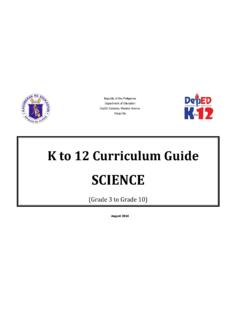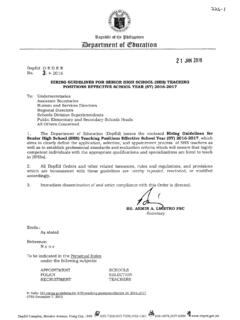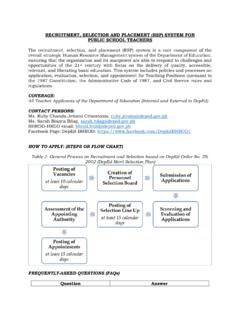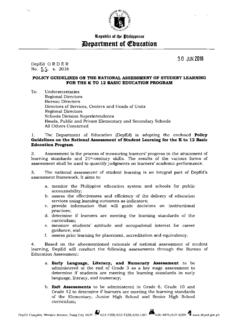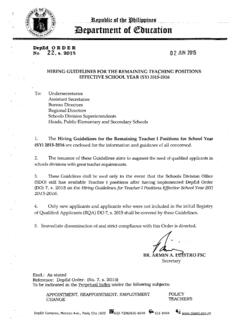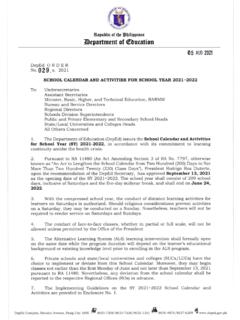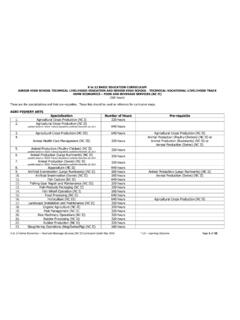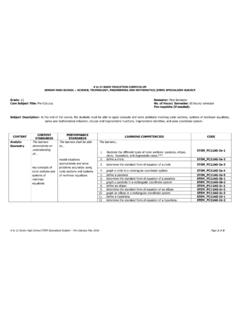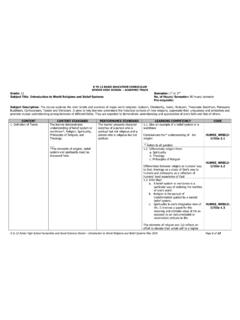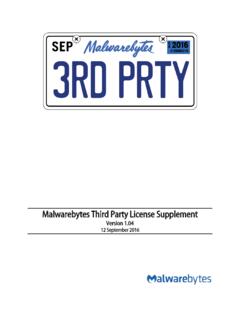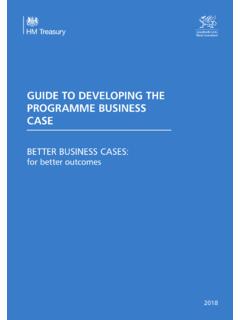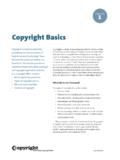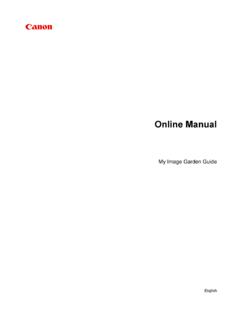Transcription of K to 12 BASIC EDUCATION CURRICULUM SENIOR HIGH …
1 K to 12 BASIC EDUCATION CURRICULUM SENIOR HIGH SCHOOL CORE SUBJECT K to 12 SENIOR High School Core CURRICULUM Reading and Writing Skills December 2013 Page 1 of 8 Grade: 11/12 Semester: 2nd Semester Core Subject Title: Reading and Writing Skills No. of Hours/ Semester: 80 hours/semester Pre-requisite: Core Subject Description: The development of reading and writing skills as applied to a wide range of materials other than poetry, fiction and drama CONTENT CONTENT STANDARD PERFORMANCE STANDARD LEARNING COMPETENCIES CODE Reading and Thinking Strategies across Text types A.
2 Text as Connected Discourse B. techniques in Selecting and Organizing Information C. Patterns of Development D. Properties of a well-written Text The realizes that information in a written text may be selected and organized to achieve a particular purpose. The critiques a chosen sample of each pattern of development focusing on information selection, organization, and development. The 1. Describes a written text as connected discourse EN11/12 RWS-IIIa-1 2. Distinguishes between and among techniques in selecting and organizing information a.
3 Brainstorming list b. graphic organizer c. topic outline d. sentence outline EN11/12 RWS-IIIa-2 EN11 EN11 EN11 EN11 3. Distinguishes between and among patterns of development in writing across disciplines a. narration b. description c. definition d. exemplification / classification e. comparison and contrast f. cause and effect g. problem - solution h. persuasion EN11/12 RWS-IIIbf-3 EN11 EN11 EN11 EN11 EN11 EN11 EN11 EN11 4. Identifies properties of a well-written text a. organization b. coherence and cohesion c. language use d. mechanics EN11/12 RWS-IIIgh-4 EN11 EN11 EN11 EN11 K to 12 BASIC EDUCATION CURRICULUM SENIOR HIGH SCHOOL CORE SUBJECT K to 12 SENIOR High School Core CURRICULUM Reading and Writing Skills December 2013 Page 2 of 8 CONTENT CONTENT STANDARD PERFORMANCE STANDARD LEARNING COMPETENCIES CODE Text and Context Connections (Critical Reading) A.
4 Critical Reading as Looking for Ways of Thinking 1. Explicit and Implicit Claims in a Text 2. Context of Text Development B. Critical Reading as Reasoning 1. Formulating Evaluative Statements 2. determining Textual Evidence understands the relationship of a written text and the context in which it was developed. writes a 1000-word critique of a selected text on the basis of its claim/s, context, and properties as a written material. 1. Explains critical reading as looking for ways of thinking EN11/12 RWS-IIIij-5 2. Identifies claims explicitly or implicitly made in a written text a.
5 Claim of fact b. Claim of policy c. Claim of value EN11/12 RWS-IIIij-6 EN11 EN11 EN11 3. Identifies the context in which a text was developed a. Hypertext b. Intertext EN11/12 RWS-IVac-7 EN11 EN11 4. Explains critical reading as reasoning EN11/12 RWS-IVac-8 5. Formulates evaluative statements about a text read a. Formulates assertions about the content and properties of a text read b. Formulates meaningful counterclaims in response to claims made in a text read EN11/12 RWS-IVac-9 EN11 EN11 6. Determines textual evidence to validate assertions and counterclaims made about a text read EN11/12 RWS-IVac-10 Purposeful Writing in the Disciplines and for Professions understands the requirements of composing academic writing and professional correspondence.
6 Produces each type of academic writing and professional correspondence following the properties of well-written texts and process approach to writing. 7. Explains how one s purpose is a crucial consideration in academic and professional writing EN11/12 RWS-IVdg-11 8. Identifies the unique features of and requirements in composing texts that are useful across disciplines a. Book Review or Article Critique b. Literature Review c. Research Report d. Project Proposal e. Position Paper EN11/12 RWS-IVdg-12 EN11 EN11 EN11 EN11 K to 12 BASIC EDUCATION CURRICULUM SENIOR HIGH SCHOOL CORE SUBJECT K to 12 SENIOR High School Core CURRICULUM Reading and Writing Skills December 2013 Page 3 of 8 CONTENT CONTENT STANDARD PERFORMANCE STANDARD LEARNING COMPETENCIES CODE 9.
7 Identifies the unique features of and requirements in composing professional correspondence a. Resume b. Application for College Admission c. Application for Employment d. Various forms of Office Correspondence EN11/12 RWS-IVhj-13 EN11 EN11 EN11 EN11 K to 12 BASIC EDUCATION CURRICULUM SENIOR HIGH SCHOOL CORE SUBJECT K to 12 SENIOR High School Core CURRICULUM Reading and Writing Skills December 2013 Page 4 of 8 GLOSSARY Connected Discourse "Connected speech is more than just a string of individual target segments joined together in series, since each segment is liable to influence the segments that surround it.
8 The precise form that these influences take is determined by the particular language in question, and so the phonology of connected speech is part of the phonology of the language that the child has to master .." (Sara Howard, Bill Wells, and John Local, "Connected Speech." The Handbook of Clinical Linguistics, ed. by Martin J. Ball, Michael R. Perkins, Nicole Muller, and Sara Howard. Blackwell, 2008) Connected speech, or connected discourse, in linguistics, is a continuous sequence of sounds forming utterances or conversations in spoken language.
9 Analysis of connected speech shows sounds changes affecting linguistic units traditionally described as phrases, words, lexemes, morphemes, syllables, phonemes or phones.[1] The words that are modified by those rules will sound differently in connected speech than in citation form (canonical form or isolation form). coherence It is the unifying element in good writing. It refers to the unity created between the ideas, sentences, paragraphs and sections of a piece of writing. Coherence is what gives a piece of writing its flow. It also gives the reader a sense of what to expect and, therefore, makes the reading easier to follow as the ideas appear to be presented in a natural, almost automatic, way.
10 In Linguistics, it is the property of unity in a written text or a segment of spoken discourse that stems from the links among its underlying ideas and from the logical organization and development of its thematic content. cohesion The use of repetition, transitional expressions, and other devices (cohesive cues) to guide readers and show how the parts of a composition relate to one other. In Linguistics, it is the property of unity in a written text or a segment of spoken discourse that stems from links among its surface elements, as when words in one sentence are repeated in another, andespecially from the fact that some words or phrases depend for their interpretation upon material inpreceding or following text, as in the sequence Be assured of this.
